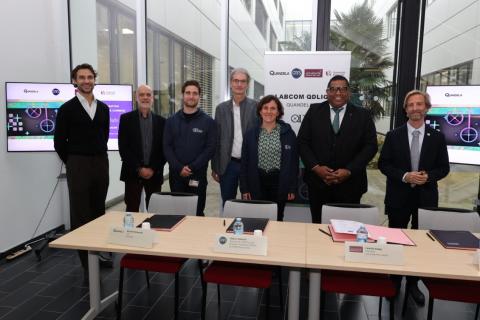Quandela, the CNRS, Université Paris- Saclay and Université Paris Cité join forces to accelerate research and innovation in quantum photonics
On 13 th of November 2024, Quandela, the CNRS, Université Paris-Saclay, and Université Paris Cité inaugurated at the Centre for Nanoscience and Nanotechnology (CNRS/Université Paris-Saclay/Université Paris Cité) the QDlight associated research laboratory focusing on research in quantum photonics, which is to say the art of controlling light in the quantum regime inside nanoscale devices. Over the course of six years, the teams will expand scientific cooperation with a view to developing next generation quantum light emitters, as well as their applications in quantum information technology to secure unprecedented computing power.
From left to right: Niccolo Somaschi (Quandela co-founder and CEO), Giancarlo Faini (Director of Centre for Nanoscience et Nanotechnology), Valérian Giesz (Quandela co-founder and COO), Thierry Dauxois (Director of CNRS Physique and CNRS Specialist Scientific Director at Paris-Saclay), Pascale Senellart-Mardon (CNRS Research Director and Quandela co-founder), Camille Galap (President of Université Paris-Saclay), Antoine Kouchner (Vice-President Strategy International Relations of Université Paris Cité) © Xavier Pierre
Quantum photonics, or the art of controlling light in the quantum regime
Quantum photonics, which has been developed since the late twentieth century, seeks to take advantage of the specifically quantum properties of light—especially single photons (emitted one by one)—for quantum computing and communications security. This discipline offers one of the most promising avenues for quantum computing (quantum computers and networks), as well as for inviolable key distribution protocols in encryption (quantum cryptography).
Quandela, a leading European company for photonic quantum computing that emerged from the Centre for Nanoscience and Nanotechnology (CNRS/Université Paris-Saclay/Université Paris Cité), has produced and marketed quantum light emitters in Europe since 2017–components that are indispensable to photonic quantum. These emitters, which consist of a quantum dot that behaves like an artificial atom in a semiconductor matrix, can generate a series of on-demand and indistinguishable single photons through a succession of laser pulses concentrating on this artificial atom
In the optimal resonance and photon extraction conditions provided by the optical cavity in which it is positioned, these quantum dots can generate a photon flux with a rate of a few dozen megahertz, which efficiently implement quantum computing protocols on a photonic chip.
Toward unprecedented computing power and efficiency
This new associated research laboratory aims to develop emitters and protocols to generate new quantum states of light, with a view to creating a fault-tolerant photonic quantum computer(1), and to demonstrating quantum communication protocols
To this end, the research will pursue two research focuses:
- The project’s “optical” focus will first develop quantum photonic entanglement protocols(2) in order to create multi-partite entangled photon chains and graphs. These non-classical states of light are central to the “made-to-measure” quantum computing paradigm, which is the most promising framework for creating a universal quantum machine
- The “growth” research focus will concentrate on the quality of the quantum-dot-based photonic devices that will be produced within the Labcom. This will notably involve growing materials of very high purity–on which the “quantum purity” of photons depends–as well as increasing the reproducibility of photonic device production.
QDlight, pursuing close public-private research collaboration
This associated research laboratory (Labcom) is in line with the collaboration, since 2017, between Quandela and the research laboratory from which it emerged, the Centre for nanoscience and Nanotechnology. This collaboration led to numerous interactions between researchers and engineers for basic research on the physics of semiconductor quantum dots, light-matter interaction in solid microcavities, protocols for the generation and measurement of quantum light, and for the first implementation of quantum protocols and computing
The QDlight Labcom represents the next phase in conserving a global competitive head-start in semiconductor single-photon source technology, in addition to ensuring their constant improvement and using their exceptional properties in research and development activities.
Notes :
1 A quantum computer is a machine that uses quantum bits or “qubits” (in this case, single photons) that present the two states of 0 or 1, which can exist simultaneously by forming coherent superpositions of 0 and 1 (in the quantum mechanics sense), whereas its classical counterpart presents information in binary form (either 0 or 1). For a quantum machine, computing power increases exponentially with the number of qubits and with just fifty qubits can surpass that of the best classical supercomputers for certain tasks.
2 Called “spooky action at a distance” by Einstein, quantum entanglement is a phenomenon in which two particles, in this specific case two photons, form a system of interdependence and correlation for their observed physical properties, regardless of the distance separating them.

